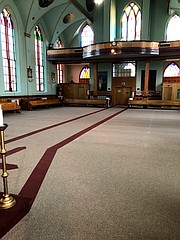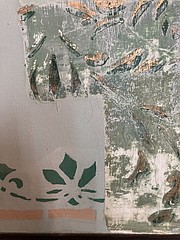Historic mission church restoration nearly completed
ST. IGNATIUS — After three summers of painstaking, intricate, loving labor and artistry, the lion’s share of the St. Ignatius Mission Church restoration project is completed.
Father C. Hightower, S.J., came to the church three years ago, just as the restoration work was ready to begin, and has helped shepherd the project. The work included repairing and reconstructing parts of the plaster and lath walls, as well as restoring the famous dry frescos of Brother Carignano to their original luster.
“The plaster itself was failing. Chunks were falling off,” Hightower said. “We had whole sections that we were losing.”
Boise-based Custom Plaster, led by restoration artist Greg Marsters, was one of two companies in the United States qualified to tackle such a difficult and historic undertaking, Hightower said.
“We were very lucky to have them.”
Work began in the summer of 2018, but fundraising had been underway long before that. Though the church is on the National Historic Registry, it is not eligible for government funds as it is still an active church. The project has been funded through community and visitor donations large and small, matching grants, benefit concerts, including the interfaith “Lamb of God” Easter cantata, and other events.
“We are incredibly grateful to this entire community that has allowed us to complete this project,” Hightower said. “This is an active Catholic church, but it is really a community resource. Everyone uses it, and we welcome that.”
Hightower particularly appreciates that the church is considered a valuable part of the tribal community, explaining that the Salish and Kootenai people invited the Jesuits to move their parish to the Mission Valley in 1854 after flooding problems in and around Usk, Washington.
Since its construction in the early 1890s, the church has undergone probably three other restorations, Hightower said. The current extensive effort includes removing some of the paint and varnish from those earlier restorations to return the original colors and details, as well as making structural improvements with the intent to last another hundred years. The “high” work, including the intensive repair and restoration of the ceiling frescos, has been completed.
Hightower marvels at the details in some of frescos which he has been able to appreciate up close, thanks to the scaffolding that has filled the church these past summers.
“This was the third or fourth church (Carignano) painted. I think he had developed his technique and theology by this time,” Hightower said, pointing out the intense longing in the eyes of the older brother of the prodigal son, and other story enhancements by the artist.
Each painting has been refreshed with the removal of deteriorating finishes placed by previous restorers. Cracks have been repaired, and original details revived. The new paints can be detected with UV light so that future restorers can easily differentiate them from the originals. “Maybe in the future, restoration techniques will be even better, and they will want to replace this work,” Hightower said.
One more summer of work remains, mainly on the walls. A major project in the 1950s, just prior to the church’s centennial, resulted in much of the intricate scrollwork on the window sills and pilasters being covered in layers of light green paint. This was possibly to highlight the famous murals, Hightower said. Small areas of these layers are being carefully removed to expose the original scrollwork, some of it in gold leaf. From small sample areas, stencils are made to replicate and redo the original patterns.
The church is fully open to the public for visits, as well as for Sunday, Monday and Friday Mass. COVID safety procedures are in place: masks and social distancing are required. Kneelers and every other pew have been removed to enable distancing; surfaces are cleaned and sanitized daily and between services. The church consulted with the Confederated Salish and Kootenai Tribes prior to reopening, after closing to all but video services early in the pandemic.
“We want people to come to church, but we also want to keep people healthy. It’s very important to protect our elders and our community,” Hightower said.
One of the things that did not change through the restoration is the angelic acoustics of the interior. The church celebrated its traditional Christmas Eve midnight mass, with the choir singing carols at 11 p.m.
Service schedules are available at stignatiusmission.org or by calling 406-745-2768. The website also offers videos of the restoration project.








